Unconventional fighters for independence and enterprising policemen. Squeaky poverty with poverty and enclaves of prosperity. Criminal riddles and hunting supernatural creatures. The life of Poles 150 years ago was full of absurdities and contrasts. It's high time to discover them!
As always, all TOP10 items are based on the articles we publish. This time we decided to present the profiles of Poles under the partitions and their dilemmas.
Who would have expected:
10. Attacks were our specialty
From 1905, an uprising on a previously unlisted scale lasted for almost ten years. Poles, deprived of open combat opportunities, resorted to terrorist methods. Only in 1906 they made 1245 attacks - statistically at least three a day.

Polish streets turned into a war zone. Bomb attacks have become commonplace.
The Polish Socialist Party formed units of professional commandos trained in combat, espionage, terrorist actions and the construction of explosives. Trains were successfully raided and bombs were thrown at representatives of the tsarist generals. Prisoners from strictly guarded outposts were freed and plans were made to kill the tsar.
No enemy official could feel safe. Attacks were carried out on generals, high-ranking officials and governors until they were carried out. This activity was discontinued only when the chance for Polish independence appeared on the horizon (read more about it) .
9. Galicia was the Qatar of Europe
Spills of spontaneous oil in the Galician Bóbrka happened for centuries - the locals called it tar or rock oil and used it to lubricate the wheels or as a medicine for sheep. When the use for it was discovered, it was a huge mining boom.
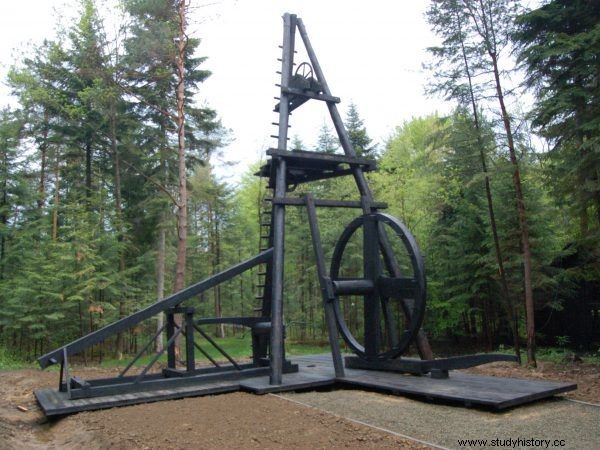
After the discovery of new uses for "tar", the landscape of Bóbrka has changed beyond recognition. In this contemporary photo, we can see the hoist tower from the Museum of Oil and Gas Industry named after Ignacy Łukasiewicz in Bóbrka (photo:Wistula, license CC BY 3.0).
Oil workers, working in wells up to two hundred meters deep, were exposed to the risk of being buried, flooded with water or suffocated by the influx of oil or gas. Many fatal incidents have been reported. The sick or crippled worker fell into extreme poverty. Many fled to do urgent farm work, such as ... milking a cow.
Despite this, the oil workers distinguished themselves by their clothes and pocket watches, and they ate their lunch with meat. Prosperity was seen in the condition of roads, fiefs and buildings. In Bóbrka, the employees were perfectly trained to their profession. As a result, they were snapped up wherever there was oil:in Russia, Chile, New Zealand, Trinidad or the Dutch India (read more about it) .
8. The teacher's lot was hard
In September 1875 the teacher , appeared before the St. Petersburg court who stole items worth more than a hundred silver rubles. Despite the obvious guilt, the jury released him from liability and made a contribution by handing him one hundred and fifty silver rubles . Reason? Extreme poverty that moved the judges. The situation of this teacher was not exceptional. His colleagues in the Polish lands also had nothing to put into the pot.
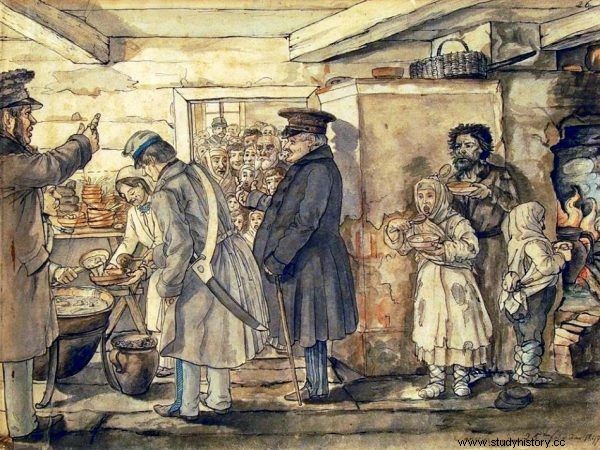
More than one 19th-century teacher would be eager to get a free meal ... Jan Gniewosz's painting "Handing out meals in Sanok" (source:public domain).
In the villages, peasants behaved aggressively, did not trust teachers and were reluctant to pay school fees. They didn't understand why they were supposed to keep the parasite. Because if they couldn't write and count themselves, why would their children need it?
Starvation wages were not enough to support me. The teachers had to take extra work to make ends meet. In 1814, the teaching of church music and singing was introduced to teachers' seminars, so that the graduate could earn extra money as an organist. All jobs were caught - the teachers were church teachers, clerks and communal writers! Because the teacher's salary could only be vegetated (read more on this topic) .
7. You could pay for the New Year's Eve party with your life
Before the New Year's Eve tradition was born, Poles played with black magic and frolics. The spells were performed from church songbooks and from the Bible. Sometimes the omens obtained in this way brought a pale fear to the unfortunate. More than one gave up the ghost by reading verses from the Old Testament or the Apocalypse of St. John.

The last night of the year resembled St. Andrew's Day in many ways. Henryk Siemiradzki's painting "Saint Andrew's Night" from 1867 (source:public domain).
The women spread a special cake in a trough placed on the straw. This straw was put on the head as a magic hat, and people backed up a ladder to the roof of the house to look at the chimney. The goal was simple:to see the faces of people who were to die in the near future. In Masuria, one brave blacksmith dared to look into the chimney, where he saw himself. After leaving the roof he gave up his ghost immediately.
Around midnight, young men appeared in front of the houses and started shooting with the whip. When the hosts went to sleep, mischief began. The cattle were driven to the neighbor's farm in Cichacz, and even carts were placed on the roofs of the houses. At dawn, such a sight raised smiles on the faces at first, but later caused trouble. Sometimes the landlord even had to re-fit the roof (read more about this) .
This article has more than one page. Please select another one below to continue reading.Attention! You are not on the first page of the article. If you want to read from the beginning click here.
6. PKP had a "worthy" ancestor
Work on the first railway in Congress Poland encountered incredible absurdities and difficulties. The originators were two Polish financiers, Piotr Steinkeller and Henryk Łubieński, but the decision to build was made by Tsar Mikołaj I. He was persuaded to do so by ... the governor of the Kingdom of Poland, Iwan Paskiewicz. The Poles owed the railway to a man who brutally suppressed the November Uprising .
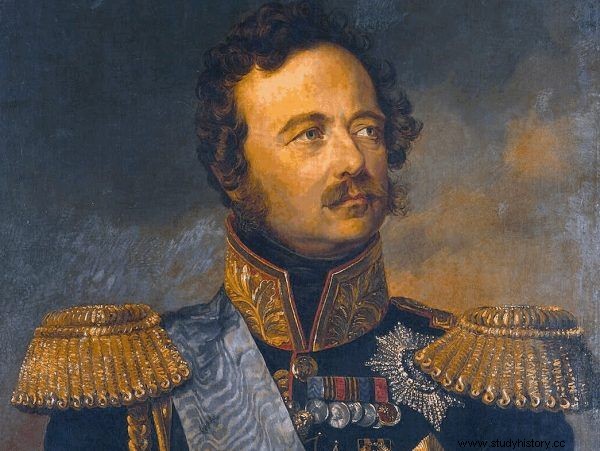
Ironically, Iwan Paskiewicz decided that the Kingdom of Poland would be given the possibility of a civilization leap related to the construction of the railway. A man who brutally suppressed the November Uprising and suppressed Polishness. Painting by Friedrich Randell (source:public domain).
Five thousand shares were issued to cover the costs. However, Piotr Steinkeller and Henryk Łubieński miscalculated about their popularity. In the end, they went so far as to hand over 1,500 shares to a British company that would pay for them by supplying fourteen thousand rails.
Faced with financial problems, Steinkeller and Łubieński decided to cut costs. They even suggested that the trains should pull horses. However, a special state commission forced the implementation of the "steam" variant. Then one of the investors went bankrupt, and the industrialist Maurycy Koniar persuaded the authorities to cancel the contract with the English for the supply of rails. His factory could produce them at an inflated price. Eventually, construction was suspended (read more about that) .
5. Sherlock Holmes (almost) visited us
Arthur Conan Doyle, author of Sherlock Holmes, did surprisingly well as a detective and cleared up several criminal mysteries in England. No wonder that in 1913 he received a letter asking for help from Congress Poland .
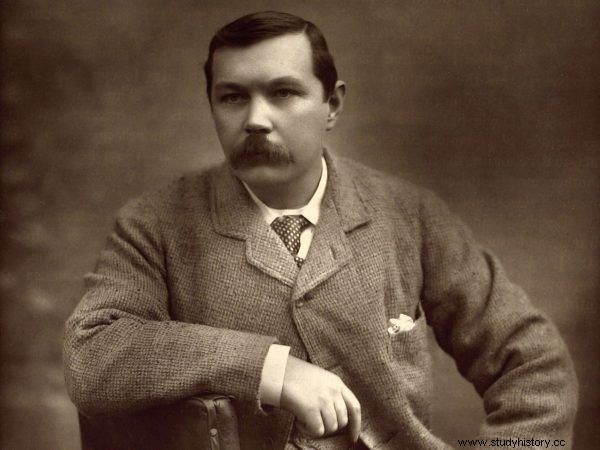
Arthur Conan Doyle solved criminal riddles not only in the pages of his novels ... Photo by Herbert Rose Barraud from 1893 (source:public domain).
Duke Władysław Drucki-Lubecki, murdered six months earlier in Teresin near Warsaw, and the alleged murderer, M. de Bisping, were well known in the Warsaw society. It has been suggested that they quarreled over money. There were two gunshot wounds inflicted from the rear. Bisping was found guilty and sentenced to "elation murder". However, successive trials, which continued for fourteen years, led him to be cleared of all charges.
Unfortunately, Arthur Conan Doyle did not come to the Vistula. The writer may have been afraid of possible political overtones of the case. It was an open secret that he was involved in the murder of the tsarist spies because Drucki and Bisping acquired properties around Fort Grodno, where large fortifications were planned to be built and both partners were to be disposed of. Was the writer then scared of Ochrana? (read more about this) .
4. The last werewolf hunt has taken place
On July 7, 1901, in the small village of Myscowa near Krosno, shepherds looked after the herd when the animals were attacked by a wolf. He grabbed one sheep and fled into the wilderness. The shepherds rushed after the kidnapper. When they almost grabbed him, the wolf managed to lose the pursuit. Instead, on the road suddenly appeared ... a local beggar Iwan Karczmarczyk .

For the inhabitants of the village of Myscowa, the werewolf probably looked like the one from the 16th-century woodcut.
Although the man was an infirm old man, who wandered from village to village on alms, the shepherds mistook him for a werewolf who has managed to return to human form. He collected from the shepherds who demanded the return of the sheep, solid strings. The innkeeper tried to run away, but the enraged herd keepers caught up with him.
Dread to think how it would have ended if the gendarme had not come. The officer saved the alleged werewolf's life and reported the whole situation to the municipal court. All the accused were found guilty of brutal beatings of an innocent grandfather and sentenced to several days' arrest. Mr. Karczmarczyk was the last man who was accused in Poland of being a werewolf (read more on this topic) .
3. An alluring woman could hide explosive contents
In 1905, queues of women began to line up to the militias fighting in Poland, some of whom wanted to personally participate in the attacks. No one was surprised that a young, beautiful lady killed two policemen with five shots, and the old lady killed a guardian.
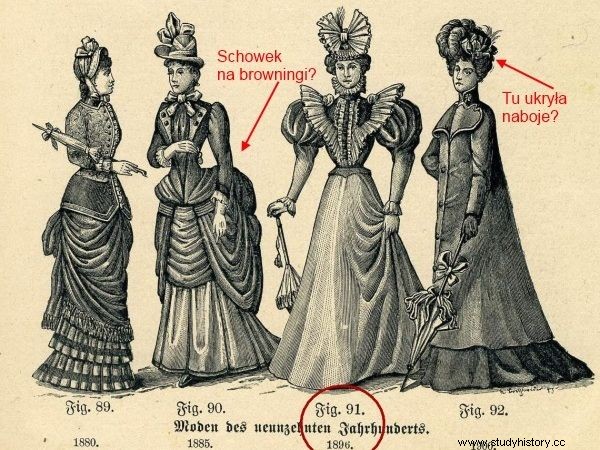
The women's clothing at the turn of the 19th and 20th centuries turned out to be a perfect hiding place for carrying weapons, ammunition and explosives.
In the first decade of the twentieth century, girls willingly produced bombs in laboratories. They also dealt with the transport of the arsenal, and their aid was… fashion. The ladies wore extensive clothes. A woman in a long dress was free to carry two body-tied mausers along the legs. Revolvers and ammunition were sewn into wide stripes, placed under the clothes. The corset was perfect for storing dynamite.
The thin and tall companions were the most capacious. Such Mrs. Morawiecka took shape when she was wearing about sixteen kilograms of tissue paper. The future Marshal herself took part in the robbery of the train near Bezdany, and her first meeting with Józef Piłsudski took place between baskets with brownings, Mausers and ammunition (read more on this topic) .
This article has more than one page. Please select another one below to continue reading.Attention! You are not on the first page of the article. If you want to read from the beginning click here.
2. There were real witchers
The Shepherd from Chernostov fought against the monsters like a purebred witcher. He was a man-institution in the region. Apparently, he was sent for him even from aristocratic mansions near Łomża and Płock. He arrived at the scene of the action armed with a sack that he would not let anyone look into.

The Shepherd of Chernostov was hardly like Geralt of Rivia. He probably looked more like the figure in the painting by Boris Wasiliewicz Smirnow (source:public domain).
After which he spent the night alone in the "possessed" household. It is not known what the struggle with the ghouls looked like - you could only hear the blood-curdling sounds of fighting, moans and noises like the crack of a whip. In the morning, a badly battered sheepdog with a full sack emerged from the building. What was in it was immediately drowned in the river or lake.
He had a reputation for being invincible, but also fond of money. According to legend, his streak ended when he once accepted a bribe from… a captured scourge. Greed did not pay off - since then, the evil spirits no longer listened to him, and he himself died a beggar (read more on this topic) .
1. The police operated "too" efficiently
In mid-1899, Prince Aleksander Imeretyński visited Łódź. A visitor showed up at the local military garrison, where discovered that his gold commemorative cigarette case had disappeared. The head of the Lodz Investigation Office, Jan Kowalik, was to find the perpetrator and the subject of the theft.

Governor-General Aleksander Imeretyński on the lithography of Piotr Borel from 1877 (source:public domain).
The case has stalled. In this situation, Kowalik found help from the resourceful Wiktor Grün. He proposed to find out who made the Prince's cigarette case so that he should make an identical one. A scapegoat was also needed. When one of the officers of the Łódź garrison committed suicide, Grün went to the camp grounds and buried his cigarette case in the ground.
Now it was time to get ready for rewards for retrieving the memento. Kowalik personally took the cigarette case to the prince to Warsaw. There, however, it turned out that ... it was not stolen at all. Imeretyński simply left it in his coat pocket, and later forgot to inform the police about it. He summed up the whole matter with an ironic statement: Our police is very efficient. It can even find what has not been lost (read more about this) .
